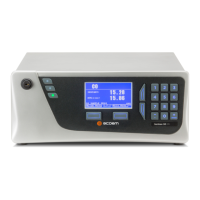TÜV Rheinland Energie und Umwelt GmbH
Luftreinhaltung
Seite 82 von 253
Report on the performance testing of the Serinus 30 ambient air quality
monitoring system manufactured by Ecotech Pty Ltd measuring CO, Report
EP_Ecotech_Serinus30_en.docx
7.1 8.4.6 Lack of fit of linearity of the calibration function
The lack of fit of the calibration function shall not exceed 0.5 µmol/mol (i.e. 0.58
mg/m³) at zero point and 4 % of the measured value at concentrations above zero.
7.2 Test procedure
The lack of fit of linearity of the calibration function of the analyser shall be tested over the
range of 0 % to 95 % of the maximum of the certification range of CO, using at least six con-
centrations (including the zero point). The analyser shall be adjusted at a concentration of
about 90 % of the maximum of the certification range. At each concentration (including zero)
at least five individual measurements shall be performed.
The concentrations shall be applied in the following sequence: 80 %, 40 %, 0 %, 60 %, 20 %
and 95 %. After each change in concentration, at least four response times shall be taken in-
to account before the next measurement is performed.
Calculation of the linear regression function and residuals shall be performed according to
Annex A of DIN EN 14626. All the (relative) residuals from the linear regression function shall
fulfil the criteria as stated above.
Establishing the regression line:
A regression line in the form of
is established through calculation of the func-
tion
To calculate the regression, all measuring points (including zero) are taken into account. The
total number of measuring points n is equal to the number of concentration levels (at least six
including zero) multiplied by the number of repetitions (at least five) at each concentration
level.
The coefficient a is obtained from
where
a is the average of the Y-values;
Y
i
is the individual Y-value;
n is the number of calibration points
The coefficient B is obtained from
( )
2
)(/)(
zizii
XXXXYB −−=
∑∑

